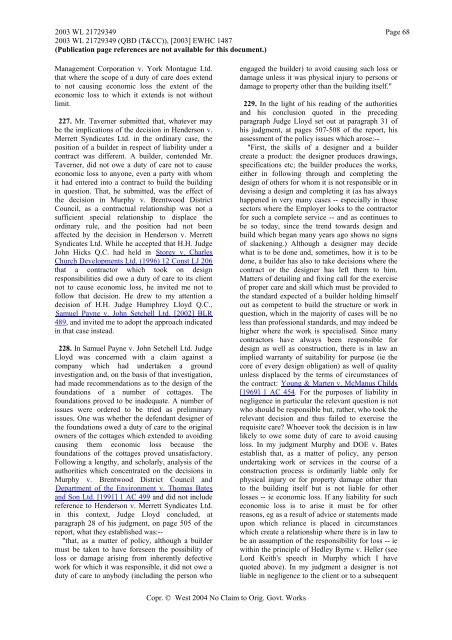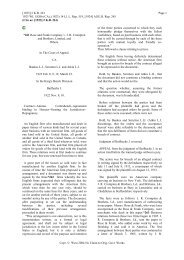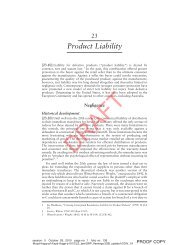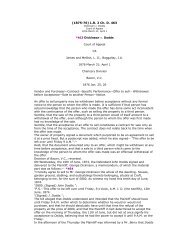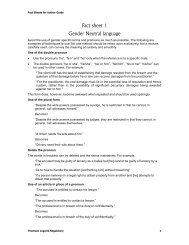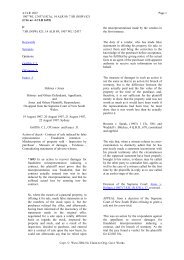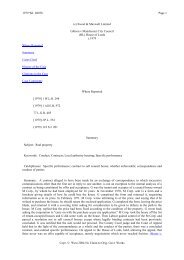Tesco v Constain - Thomson Reuters
Tesco v Constain - Thomson Reuters
Tesco v Constain - Thomson Reuters
Create successful ePaper yourself
Turn your PDF publications into a flip-book with our unique Google optimized e-Paper software.
2003 WL 21729349 Page 682003 WL 21729349 (QBD (T&CC)), [2003] EWHC 1487(Publication page references are not available for this document.)Management Corporation v. York Montague Ltd.that where the scope of a duty of care does extendto not causing economic loss the extent of theeconomic loss to which it extends is not withoutlimit.227. Mr. Taverner submitted that, whatever maybe the implications of the decision in Henderson v.Merrett Syndicates Ltd. in the ordinary case, theposition of a builder in respect of liability under acontract was different. A builder, contended Mr.Taverner, did not owe a duty of care not to causeeconomic loss to anyone, even a party with whomit had entered into a contract to build the buildingin question. That, he submitted, was the effect ofthe decision in Murphy v. Brentwood DistrictCouncil, as a contractual relationship was not asufficient special relationship to displace theordinary rule, and the position had not beenaffected by the decision in Henderson v. MerrettSyndicates Ltd. While he accepted that H.H. JudgeJohn Hicks Q.C. had held in HStorey v. CharlesChurch Developments Ltd. (1996) 12 Const LJ 206that a contractor which took on designresponsibilities did owe a duty of care to its clientnot to cause economic loss, he invited me not tofollow that decision. He drew to my attention adecision of H.H. Judge Humphrey Lloyd Q.C.,HSamuel Payne v. John Setchell Ltd. [2002] BLR489, and invited me to adopt the approach indicatedin that case instead.228. In Samuel Payne v. John Setchell Ltd. JudgeLloyd was concerned with a claim against acompany which had undertaken a groundinvestigation and, on the basis of that investigation,had made recommendations as to the design of thefoundations of a number of cottages. Thefoundations proved to be inadequate. A number ofissues were ordered to be tried as preliminaryissues. One was whether the defendant designer ofthe foundations owed a duty of care to the originalowners of the cottages which extended to avoidingcausing them economic loss because thefoundations of the cottages proved unsatisfactory.Following a lengthy, and scholarly, analysis of theauthorities which concentrated on the decisions inMurphy v. Brentwood District Council andHDepartment of the Environment v. Thomas Batesand Son Ltd. [1991] 1 AC 499 and did not includereference to Henderson v. Merrett Syndicates Ltd.in this context, Judge Lloyd concluded, atparagraph 28 of his judgment, on page 505 of thereport, what they established was:--"that, as a matter of policy, although a buildermust be taken to have foreseen the possibility ofloss or damage arising from inherently defectivework for which it was responsible, it did not owe aduty of care to anybody (including the person whoengaged the builder) to avoid causing such loss ordamage unless it was physical injury to persons ordamage to property other than the building itself."229. In the light of his reading of the authoritiesand his conclusion quoted in the precedingparagraph Judge Lloyd set out at paragraph 31 ofhis judgment, at pages 507-508 of the report, hisassessment of the policy issues which arose:--"First, the skills of a designer and a buildercreate a product: the designer produces drawings,specifications etc; the builder produces the works,either in following through and completing thedesign of others for whom it is not responsible or indevising a design and completing it (as has alwayshappened in very many cases -- especially in thosesectors where the Employer looks to the contractorfor such a complete service -- and as continues tobe so today, since the trend towards design andbuild which began many years ago shows no signsof slackening.) Although a designer may decidewhat is to be done and, sometimes, how it is to bedone, a builder has also to take decisions where thecontract or the designer has left them to him.Matters of detailing and fixing call for the exerciseof proper care and skill which must be provided tothe standard expected of a builder holding himselfout as competent to build the structure or work inquestion, which in the majority of cases will be noless than professional standards, and may indeed behigher where the work is specialised. Since manycontractors have always been responsible fordesign as well as construction, there is in law animplied warranty of suitability for purpose (ie thecore of every design obligation) as well of qualityunless displaced by the terms of circumstances ofthe contract: HYoung & Marten v. McManus Childs[1969] 1 AC 454. For the purposes of liability innegligence in particular the relevant question is notwho should be responsible but, rather, who took therelevant decision and thus failed to exercise therequisite care? Whoever took the decision is in lawlikely to owe some duty of care to avoid causingloss. In my judgment Murphy and DOE v. Batesestablish that, as a matter of policy, any personundertaking work or services in the course of aconstruction process is ordinarily liable only forphysical injury or for property damage other thanto the building itself but is not liable for otherlosses -- ie economic loss. If any liability for sucheconomic loss is to arise it must be for otherreasons, eg as a result of advice or statements madeupon which reliance is placed in circumstanceswhich create a relationship where there is in law tobe an assumption of the responsibility for loss -- iewithin the principle of Hedley Byrne v. Heller (seeLord Keith's speech in Murphy which I havequoted above). In my judgment a designer is notliable in negligence to the client or to a subsequentCopr. © West 2004 No Claim to Orig. Govt. Works


